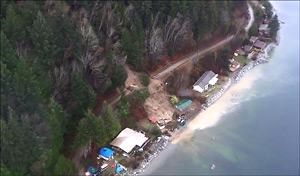Though last week’s rain storms did not break any records, three days’ accumulation took its toll on Powell River’s roads and sewers.
More than 140 millimetres of rain fell over the course of three days, December 8 through 10. On some hillsides, the ground saturated with water sloughed off and slid onto shoreline paths, into the sea or across roads.
Landslides were reported both north and south of town. On Atrevida Road near Lund, 100 cubic metres of rock and mud let go from the hillside above and blocked the road. The flow shifted one home off its foundation. South of town, residents on Stittle Road watched as approximately 1,100 cubic metres of hillside slid into the sea.
Tor Birtig, City of Powell River director of infrastructure, said his staff were still receiving telephone calls from concerned residents with drainage and sewer issues after the storm subsided.
“We were at a point with our sewer system that it was totally at capacity,” said Birtig, Monday, December 15. “We had some instances where people couldn’t flush their toilet because we were at capacity in and around the Cranberry area.”
He said the city is looking at some short-term fixes for the problem. “We’ve definitely got issues with our sanitary system,” he said. “But we are going to look at some ways to alleviate the flow concerns there. There are some options that are not going to cost us millions.”
The system was at capacity because of a combination of inflow and infiltration, he said. He explained that the system can be infiltrated when the ground around the pipes is saturated and water from outside seeps in through cracks or misaligned joints or through the manholes themselves.
It was not the intensity of the rain which caused the problem as much as it was that the ground was already saturated so water pooled, said Birtig, something a larger capacity storm sewer system would not improve. “We can’t upsize all of our mains, so we’re going to have to look for more innovative ways,” he said.
Over the three days of the storms, the city’s public works office fielded well over 80 calls from people who were having drainage issues, said Birtig. He said the larger issue for many people who reported wet basements was the over-land flow.
He added that as the frequency of storms increases, a trend coastal residents are already seeing, public works will make more effort to educate residents on what can be done to help.
“People haven’t cleaned out their homes’ perimeter drains and there are a lot of systems out there with roots,” Birtig said about vegetation impacting the drain’s function.
He suggested homeowners can disconnect the rain leaders from their gutters and let water flow away from the house’s perimeter drain. Wet basements often occur when a house’s foundation drain traps water beside it and the water seeps in.
Birtig added that on new developments, contractors have to maintain tree flows, which capture the rainwater on their property and then slowly release it into the drainage system.
Property owners affected by the flood can apply for government assistance, as detailed in this week's Quick Peak.



